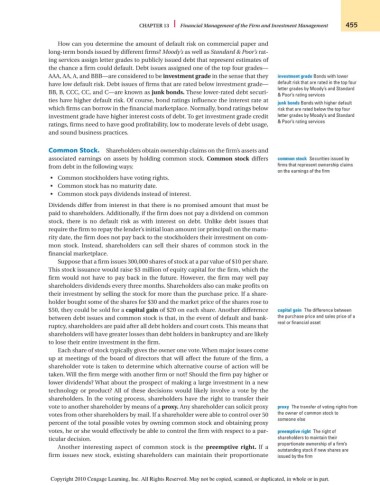Page 481 - Introduction to Business
P. 481
CHAPTER 13 Financial Management of the Firm and Investment Management 455
How can you determine the amount of default risk on commercial paper and
long-term bonds issued by different firms? Moody’s as well as Standard & Poor’s rat-
ing services assign letter grades to publicly issued debt that represent estimates of
the chance a firm could default. Debt issues assigned one of the top four grades—
AAA, AA, A, and BBB—are considered to be investment grade in the sense that they investment grade Bonds with lower
have low default risk. Debt issues of firms that are rated below investment grade— default risk that are rated in the top four
letter grades by Moody’s and Standard
BB, B, CCC, CC, and C—are known as junk bonds. These lower-rated debt securi- & Poor’s rating services
ties have higher default risk. Of course, bond ratings influence the interest rate at junk bonds Bonds with higher default
which firms can borrow in the financial marketplace. Normally, bond ratings below risk that are rated below the top four
investment grade have higher interest costs of debt. To get investment grade credit letter grades by Moody’s and Standard
& Poor’s rating services
ratings, firms need to have good profitability, low to moderate levels of debt usage,
and sound business practices.
Common Stock. Shareholders obtain ownership claims on the firm’s assets and
associated earnings on assets by holding common stock. Common stock differs common stock Securities issued by
from debt in the following ways: firms that represent ownership claims
on the earnings of the firm
• Common stockholders have voting rights.
• Common stock has no maturity date.
• Common stock pays dividends instead of interest.
Dividends differ from interest in that there is no promised amount that must be
paid to shareholders. Additionally, if the firm does not pay a dividend on common
stock, there is no default risk as with interest on debt. Unlike debt issues that
require the firm to repay the lender’s initial loan amount (or principal) on the matu-
rity date, the firm does not pay back to the stockholders their investment on com-
mon stock. Instead, shareholders can sell their shares of common stock in the
financial marketplace.
Suppose that a firm issues 300,000 shares of stock at a par value of $10 per share.
This stock issuance would raise $3 million of equity capital for the firm, which the
firm would not have to pay back in the future. However, the firm may well pay
shareholders dividends every three months. Shareholders also can make profits on
their investment by selling the stock for more than the purchase price. If a share-
holder bought some of the shares for $30 and the market price of the shares rose to
$50, they could be sold for a capital gain of $20 on each share. Another difference capital gain The difference between
between debt issues and common stock is that, in the event of default and bank- the purchase price and sales price of a
real or financial asset
ruptcy, shareholders are paid after all debt holders and court costs. This means that
shareholders will have greater losses than debt holders in bankruptcy and are likely
to lose their entire investment in the firm.
Each share of stock typically gives the owner one vote. When major issues come
up at meetings of the board of directors that will affect the future of the firm, a
shareholder vote is taken to determine which alternative course of action will be
taken. Will the firm merge with another firm or not? Should the firm pay higher or
lower dividends? What about the prospect of making a large investment in a new
technology or product? All of these decisions would likely involve a vote by the
shareholders. In the voting process, shareholders have the right to transfer their
vote to another shareholder by means of a proxy. Any shareholder can solicit proxy proxy The transfer of voting rights from
votes from other shareholders by mail. If a shareholder were able to control over 50 the owner of common stock to
someone else
percent of the total possible votes by owning common stock and obtaining proxy
votes, he or she would effectively be able to control the firm with respect to a par- preemptive right The right of
ticular decision. shareholders to maintain their
proportionate ownership of a firm’s
Another interesting aspect of common stock is the preemptive right. If a
outstanding stock if new shares are
firm issues new stock, existing shareholders can maintain their proportionate issued by the firm
Copyright 2010 Cengage Learning, Inc. All Rights Reserved. May not be copied, scanned, or duplicated, in whole or in part.

